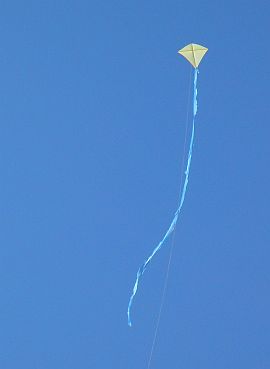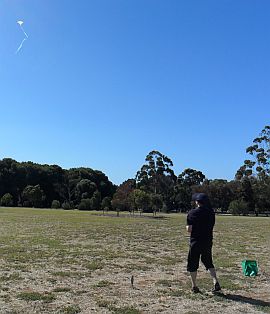- Home Page
- Flight Reports
- Sticked Diamonds
- Tiny Tots Diamond
Tiny Tots Diamond Kite
High Up in a Very Gusty Breeze
Today's flying was a real family affair with a kite for each of us.
 MBK Tiny Tots Diamond
MBK Tiny Tots DiamondOur original Tiny Tots Diamond kite was created as an "idiot-proof super-quick" design. There's an army of parents out there who are looking for these qualities in a kite to make for their child. It had better be easy, it had better be quick to make, and it had better fly, to avoid disappointment! ;-)
We also took my wife's Tiny Tots Diamond, which she kindly made up in order to test out the "How To..." instructions for this kite.
Finally, the little green Baby Sled was
taken too, which we bought at a kite festival for Aren years ago. He was
a toddler at the time.
We put up the Baby Sled first and let 5-year-old Aren have a fly. Although this kite struggled a bit in the fresh gusts, it did OK for half a minute or so at a time with its original two short tails. Also original was the small plastic winder and cotton flying line.
Soon after this, I put up the original yellow-sailed Tiny Tots Diamond kite on about 20 meters (70 feet) of line. Turbulence and fresh gusts kept bringing the kite to ground every few minutes, but it flew well enough to get some photos.
I decided that to give the kite a better chance of staying up, it just needed more line. This did prove to be the case, after just over 60 meters (200 feet) was let out. This allowed the tiny diamond to climb out to 100 feet or so above ground, giving a good buffer against premature landing.
On this site, there's more kite-making info than you can poke a stick at. :-) Want to know the most convenient way of using it all?
The Big MBK E-book Bundle is a collection of downloads—printable PDF files which provide step-by-step instructions for many kites large and small.
That's every kite in every MBK series.
The light-yellow sail and medium-blue tail were easily spotted against blue sky, as the kite spent most of the time high up. Occasionally it would get forced down, but the lower wind-speed near the ground always allowed it to recover and climb back.
With the winder lying on the ground and a few loops of line passed around a stake, the kite was secure. There's not much pull on a kite this size regardless of how strong the wind is!
 Up and away!
Up and away!Meanwhile, number three, the blue-sailed Tiny Tots Diamond kite went up. The only line available was the 50-pound Dacron that I use to fly the 1.2 meter (4 feet) Dowel kites. Oh well, it just won't manage to take much length then. The little diamond managed to fly up on about 20 meters of this way-too-heavy line.
The blue diamond just couldn't quite cope with the breeze strength, looping left and ending up on the ground time after time. This kite is a good flier in fairly light winds, though, as it proved on its very first flights.
Thin bamboo skewers and very thin plastic keeps the weight down. In the interests of complete simplicity, the sail has no edging either, so that's another weight saving.
Meanwhile, the yellow kite was cavorting about in the erratic fashion of simple diamonds in gusty wind. The Tiny Tots Diamond kite doesn't really have a bridle; it just has a single attachment point where the skewers cross. This is simple and easy with no adjustments required. The horizontal spar does have to be in the right spot for this to work.
Near the ground, the flying-line angle was around 15 degrees most of the time due to line weight. Gusts blew long but subtle bends in various directions into the line as it snaked out and upwards toward the kite flying in the distance.
The kite itself was holding a 30- to 40-degree angle most of the time. You can see this in the photo up there. See if you can spot the Windtronic wind meter too, a short distance to my left on the ground.
Actually, the Tiny Tots Diamond kite has an almost embarrassingly good wind range. Considering that it is my smallest simplest sparred kite design! The wind range is largely due to that super-light ribbon tail that stretches a full 10 kite lengths behind it in the breeze.
At one point, the flying line drooped itself across a bush and got
caught up in the leaves. Shortly after, having been in the air for 25
minutes, the little diamond was forced down to the ground, onto its nose.
However, it flipped over and took off again immediately!
For the next 20 minutes, we joined Aren on the play equipment near the edge of the reserve and left the kite to its own devices.
This is probably the longest and highest flight this little kite has had to date. And that's despite the breeze being extremely gusty.
To be more precise, the Windtronic wind meter sitting on its short tripod measured an average wind strength of 5.8 kph and a maximum gust of 15.3 kph. The kite might have felt close to 20 kph at times, being much higher up.
The story or stories above document actual flying experiences. My write-ups are definitely "warts and all," since things don't always go totally as planned. However, half the fun of kiting is anticipating the perfect flight. When it happens, it's magic!
As mentioned earlier, there's more kite-making info here than you can poke a stick at. :-)
Want to know the most convenient way of using it all?
The Big MBK E-book Bundle is a collection of downloads—printable PDF files which provide step-by-step instructions for many kites large and small.
That's every kite in every MBK series.
